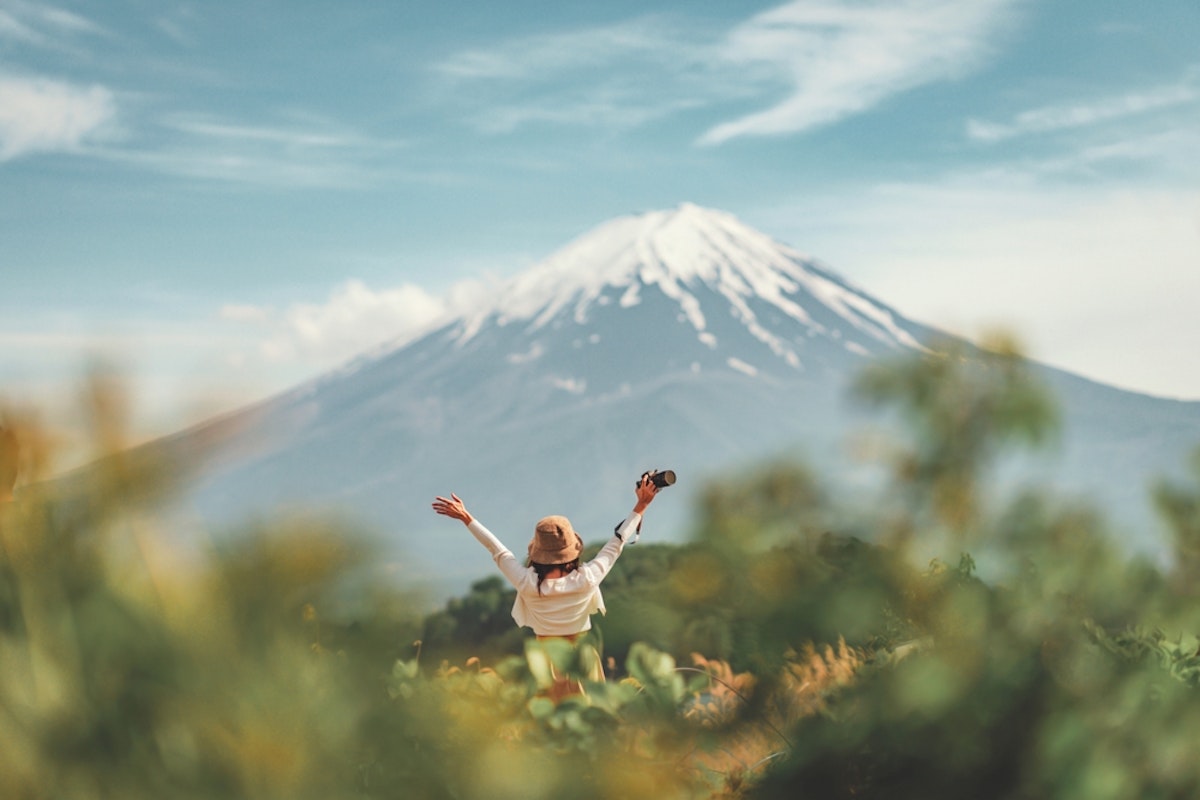

ภูเขาไฟฟูจิเป็นหนึ่งในสถานที่สําคัญที่มีชื่อเสียงที่สุดของญี่ปุ่นและเป็นสถานที่ที่ไม่ควรพลาดสําหรับทุกคนที่มาเยือนประเทศ ตั้งอยู่ที่ความสูง 3,776 เมตร ไม่ใช่แค่ภูเขา แต่เป็นสัญลักษณ์ของความงามและวัฒนธรรมของญี่ปุ่น ไม่ว่าคุณจะต้องการชื่นชมจากทะเลสาบที่เงียบสงบ ปีนขึ้นไปบนยอดเขา หรือแค่ถ่ายภาพที่ยากจะลืมเลือน ภูเขาไฟฟูจิคือการผจญภัยที่รอคอยที่จะเกิดขึ้น
ส่วนที่ดีที่สุด? มันสั้น ๆ การเดินทางจากโตเกียวทําให้ง่ายต่อการเพิ่มลงในแผนการเดินทางของคุณ คู่มือนี้จะนําคุณไปสู่วิธีที่ดีที่สุดในการเดินทาง จะเพลิดเพลินไปกับทิวทัศน์ที่ดีที่สุด และเคล็ดลับในการใช้ประโยชน์สูงสุดจากการเยี่ยมชมของคุณ เตรียมตัวให้พร้อมสําหรับประสบการณ์ที่ยากจะลืมเลือน!
เครือข่ายรถไฟในญี่ปุ่นมีประสิทธิภาพและเป็นวิธีที่ยอดเยี่ยมในการเดินทางไปยังภูเขาไฟฟูจิ พื้นที่ บัตรเจแปนเรลพาส (JR Pass) เป็นตัวเลือกยอดนิยมสําหรับนักท่องเที่ยว โดยให้บริการรถไฟ JR ได้ไม่จํากัดภายในระยะเวลาที่กําหนด

ค้นพบญี่ปุ่นอย่างไร้ขีดจํากัดด้วย JR Pass ที่เข้าถึงได้ทั้งหมดของเรา!
สาย JR Chuo และรถไฟฟูจิคิว
ขึ้นรถไฟสาย JR Chuo ไปยังสถานี Otsuki จากสถานีโตเกียวหรือสถานีชินจูกุ ที่ Otsuki เปลี่ยนไปใช้รถไฟ Fujikyu Railway ซึ่งจะพาคุณตรงไปยังสถานี Kawaguchiko ใกล้กับ พื้นที่ทะเลสาบทั้งห้าของฟูจิ. เส้นทางนี้เหมาะสําหรับผู้ที่มีบัตร Japan Rail Pass
ชินคันเซ็น (รถไฟหัวกระสุน)
ขึ้นรถไฟชินคันเซ็นโทไคโดจากโตเกียวไปยังสถานีชินฟูจิเพื่อหาทางเลือกที่รวดเร็วยิ่งขึ้น จากนั้นรถบัสจะเชื่อมต่อคุณไปยัง สถานที่ยอดนิยมรอบภูเขาไฟฟูจิ. รถไฟหัวกระสุนสะดวกเป็นพิเศษสําหรับผู้ที่มีเวลาจํากัด
รถบัสเป็นวิธีที่ราคาไม่แพงและตรงไปตรงมาในการเดินทางไปยังภูเขาไฟฟูจิ

เดินทางแบบไปเช้าเย็นกลับจากโตเกียวไปยังภูเขาไฟฟูจิและฮาโกเน่
รถบัสตรง: รถบัสประจําให้บริการจากสถานีรถบัสทางด่วนชินจูกุ สถานีโตเกียว และชิบูย่าไปยังสถานีคาวากุจิโกะ ฟูจิคิวไฮแลนด์และสถานีที่ 5 ของสายฟูจิซูบารุ โดยทั่วไปการเดินทางจะใช้เวลา 2 ถึง 3 ชั่วโมง และรถบัสจะสะดวกสบายด้วยตัวเลือกที่นั่งที่จองไว้
รถบัสทางหลวง: ออกเดินทางจากสถานีหลัก เช่น ชินจูกุ โตเกียว และชิบูย่า ซึ่งมีเที่ยวบินออกเดินทางบ่อยครั้งและที่นั่งที่สะดวกสบาย
การเช่ารถทําให้คุณสามารถสํารวจภูเขาไฟฟูจิ และพื้นที่โดยรอบได้ตามอัธยาศัย การขับรถจากโตเกียวไปยังภูเขาไฟฟูจิใช้เวลาประมาณ 2 ถึง 2.5 ชั่วโมง เป็นตัวเลือกที่ยอดเยี่ยมสําหรับครอบครัวหรือกลุ่มที่ต้องการรวมกิจกรรมหลายอย่างไว้ในทริปเดียว

เพลิดเพลินไปกับทัวร์ภูเขาไฟฟูจิแบบส่วนตัวเต็มวันด้วยรถพรีเมียม
ภูมิภาคทะเลสาบฟูจิทั้งห้า (ฟูจิโกโกะ) เป็นที่ชื่นชอบสําหรับทิวทัศน์ที่งดงามและกิจกรรมกลางแจ้ง บริเวณนี้รวมถึงทะเลสาบคาวากุจิ ทะเลสาบยามานากะ ทะเลสาบไซโกะ ทะเลสาบโชจิ และทะเลสาบโมโตสุ ทะเลสาบแต่ละแห่งมีจุดชมวิวภูเขาไฟฟูจิที่ไม่เหมือนใคร
ทะเลสาบคาวากุจิ: ทะเลสาบที่เข้าถึงได้และเป็นที่นิยมมากที่สุด พร้อมภาพสะท้อนที่สวยงามของภูเขาในวันที่สงบ
ทะเลสาบ Motosu: ทะเลสาบแห่งนี้มียอดรวม 1,000 เยนของญี่ปุ่น ให้ทิวทัศน์อันบริสุทธิ์และมีผู้คนน้อยลง
เจดีย์ห้าชั้นในศาลเจ้าอาราคุระเซนเก็นแห่งนี้เป็นหนึ่งในจุดที่มีการถ่ายภาพมากที่สุดของภูเขาไฟฟูจิ การผสมผสานระหว่างเจดีย์ ภูเขาไฟฟูจิ และดอกซากุระในฤดูใบไม้ผลิสร้างฉากที่น่าทึ่ง
ฮาโกเน่จะมองเห็นทิวทัศน์อันน่าทึ่งของภูเขาไฟฟูจิ การนั่งกระเช้าลอยฟ้าฮาโกเน่หรือการล่องเรือในทะเลสาบอาชิมักจะมีภาพรวมของภูเขา

เริ่มต้นการเดินทางที่น่าตื่นเต้นผ่านเมืองฮาโกเน่อันงดงามบนภูเขา
ทัศนวิสัยของภูเขาไฟฟูจิขึ้นอยู่กับสภาพอากาศ และท้องฟ้าแจ่มใสให้ทิวทัศน์ที่ดีที่สุด พื้นที่ ฤดูหนาว ตั้งแต่เดือนพฤศจิกายนถึงกุมภาพันธ์มักจะให้ทัศนียภาพที่คมชัดและไม่มีสิ่งกีดขวาง แม้ว่าอากาศจะหนาวเย็นก็ตาม ฤดูร้อนสามารถนําเมฆมาซึ่งบางครั้งบดบังยอดเขา
ฤดูกาลปีนเขาอย่างเป็นทางการของภูเขาไฟฟูจิเริ่มตั้งแต่ ต้นเดือนกรกฎาคมถึงต้นเดือนกันยายน เมื่อเส้นทางปลอดภัยและสิ่งอํานวยความสะดวกเปิดให้บริการ นี่เป็นครั้งเดียวที่สามารถไปถึงยอดเขาได้อย่างสะดวกสบาย
การปีนภูเขาไฟฟูจิเป็นกิจกรรมที่หลายคนต้องทํา ภูเขามีเส้นทางหลักสี่เส้นทาง โดยมี เส้นทางโยชิดะ เป็นที่นิยมมากที่สุดเนื่องจากเข้าถึงได้จากคาวากุจิโกะ นักปีนเขาส่วนใหญ่เริ่มต้นจาก สถานีที่ 5ซึ่งสามารถเข้าถึงได้โดยรถบัส
ภูเขา Huts: กระท่อมเหล่านี้เป็นจุดพักผ่อนและอาหารระหว่างการปีนเขา แนะนําให้จองล่วงหน้าในช่วงฤดูท่องเที่ยว
การดูพระอาทิตย์ขึ้น: นักปีนเขาหลายคนเริ่มปีนขึ้นในตอนกลางคืนเพื่อไปถึงยอดเขาเมื่อพระอาทิตย์ขึ้น หรือที่เรียกว่า โกไรโกะ ในภาษาญี่ปุ่น
สําหรับผู้ที่แสวงหาความตื่นเต้น ฟูจิคิวไฮแลนด์ เป็นสวนสนุกใกล้ภูเขาไฟฟูจิ ซึ่งมีชื่อเสียงในด้านรถไฟเหาะและทิวทัศน์ของภูเขา เป็นจุดแวะพักที่ยอดเยี่ยมสําหรับครอบครัวหรือใครก็ตามที่ต้องการผสมผสานความสนุกสนานกับการเที่ยวชมสถานที่

ทําให้การเยี่ยมชม Fuji-Q Highland ของคุณไม่ยุ่งยากด้วยตั๋วอิเล็กทรอนิกส์
ผ่อนคลายใน ออนเซ็น (น้ําพุร้อน) พร้อมทิวทัศน์ของภูเขาไฟฟูจิเป็นประสบการณ์ที่ยากจะลืมเลือน รีสอร์ทน้ําพุร้อนหลายแห่งในพื้นที่มีห้องอาบน้ําแบบเปิดโล่งพร้อมทิวทัศน์ของยอดเขาโดยตรง
สิ่งที่คุณแพ็คขึ้นอยู่กับกิจกรรมของคุณ สําหรับการเที่ยวชมสถานที่และการเดินทางแบบไปเช้าเย็นกลับ เสื้อผ้าที่ใส่สบาย รองเท้าที่แข็งแรง และแจ็คเก็ตบางเบาก็เพียงพอแล้ว สําหรับการปีนเขา รายการบรรจุภัณฑ์ที่มีรายละเอียดมากขึ้นเป็นสิ่งสําคัญ:
เสื้อผ้า: ชั้นต่างๆ เช่น ชั้นฐาน แจ็คเก็ตขนแกะ และชั้นนอกกันลม เหมาะอย่างยิ่งสําหรับการเปลี่ยนแปลงอุณหภูมิ
อุปกรณ์เดินป่า: รองเท้าเดินป่า ไม้ค้ํายัน และถุงมือที่ทนทาน เพื่อการยึดเกาะและการป้องกันที่ดี
สิ่งจําเป็นอื่นๆ: เสื้อกันฝน ครีมกันแดด หมวก และน้ําปริมาณมาก หากคุณกําลังปีนเขา ให้นําไฟหน้าและเงินสดมาซื้อกระท่อมบนภูเขาหรือตู้จําหน่ายสินค้าอัตโนมัติ

ภูมิภาครอบภูเขาไฟฟูจิมีอาหารท้องถิ่นและขนมท้องถิ่นมากมาย ตัวเลือกที่ต้องลอง ได้แก่ :
บะหมี่โฮโตะ: ซุปก๋วยเตี๋ยวแสนอร่อยพร้อมน้ําซุปจากมิโซะ เหมาะสําหรับวันที่อากาศหนาวเย็น
ข้าวโพดย่าง: พบได้ตามแผงลอยริมถนนหลายแห่ง เป็นที่ชื่นชอบของนักท่องเที่ยว
มัทฉะ Treats: ย่านนี้ขึ้นชื่อเรื่องชาเขียว ดื่มด่ํากับไอศกรีม ขนมหวาน หรือเครื่องดื่มรสมัทฉะ
จองล่วงหน้า: ไม่ว่าจะเป็นการเดินทาง กระท่อมบนภูเขา หรือที่พัก การวางแผนล่วงหน้าจะมีประโยชน์ โดยเฉพาะในช่วงฤดูท่องเที่ยว
ตรวจสอบสภาพอากาศ: สภาพอากาศรอบภูเขาไฟฟูจิสามารถเปลี่ยนแปลงได้อย่างรวดเร็ว ค้นหาการคาดการณ์ก่อนการเดินทางเพื่อหลีกเลี่ยงความผิดหวัง
เดินทางแต่เช้า: การมาถึงแต่เช้าตรู่จะเพิ่มโอกาสในการมองเห็นที่ชัดเจน เนื่องจากตอนเช้ามักจะมีเมฆมากน้อยกว่า
ทริปหนึ่งวันไปยังภูเขาไฟฟูจิจากโตเกียวเป็นไปได้ แต่การพักค้างคืนจะช่วยให้คุณสํารวจได้มากขึ้นและเพลิดเพลินไปกับการก้าวที่ช้าลง หากคุณวางแผนที่จะปีนเขา
พื้นที่คาวากุจิโกะ: เหมาะสําหรับการชมวิวริมทะเลสาบ เที่ยวชมสถานที่ และตัวเลือกที่พักตั้งแต่ราคาประหยัดไปจนถึงหรูหรา
ฮา โก เน่: มีบ่อน้ําพุร้อน พิพิธภัณฑ์ และจุดชมวิวผสมผสานกัน จึงเป็นฐานที่เหมาะสําหรับการสํารวจภูมิภาค

ใช้เวลาทั้งวันอย่างสนุกสนานในการสํารวจความงามของภูเขาไฟฟูจิและเพลิดเพลินกับวัฒนธรรมญี่ปุ่น
การเยี่ยมชมภูเขาไฟฟูจิมีความงามตามธรรมชาติ ประสบการณ์ทางวัฒนธรรมและช่วงเวลาที่ยากจะลืมเลือน ไม่ว่าคุณจะชื่นชมความยิ่งใหญ่จากทะเลสาบอันเงียบสงบ สํารวจสถานที่ท่องเที่ยวใกล้เคียง หรือวางแผนปีนเขาในช่วงฤดูร้อน ยอดเขาอันเป็นสัญลักษณ์แห่งนี้มีทุกสิ่งสําหรับทุกคน
ด้วยวิธีมากมายในการเพลิดเพลินไปกับการเดินทางจากโตเกียวไปยังภูเขาไฟฟูจิ เหลือเพียงวางแผนการเดินทางของคุณและดําดิ่งสู่ประสบการณ์โดยตรง
ฉันสามารถเห็นภูเขาไฟฟูจิในวันที่มีเมฆมากได้หรือไม่?
ทัศนวิสัยอาจถูกจํากัดในวันที่มีเมฆมาก โดยเฉพาะในช่วงฤดูร้อน การตรวจสอบพยากรณ์อากาศล่วงหน้าจะเพิ่มโอกาสในการมองเห็นที่ชัดเจน ฤดูหนาวมีแนวโน้มที่จะมองเห็นได้ชัดเจนกว่า
ฉันควรเตรียมอะไรให้สําหรับทริปภูเขาไฟฟูจิ
สําหรับการท่องเที่ยว ให้พกรองเท้าที่ใส่สบาย แจ็คเก็ตบางเบา และกล้องถ่ายรูป สําหรับการปีนเขา รวมถึงอุปกรณ์เดินป่า ชั้นอบอุ่น อุปกรณ์ป้องกันฝน และสิ่งจําเป็น เช่น ของว่างและเงินสด
จุดที่ดีที่สุดในการชมภูเขาไฟฟูจิโดยไม่ต้องปีนเขาคือที่ไหน?
สถานที่ยอดนิยม ได้แก่ ทะเลสาบคาวากุจิ เจดีย์ชูเรโตะ และทะเลสาบอาชิในฮาโกเน่ สถานที่เหล่านี้ให้ทิวทัศน์ที่สวยงามและสามารถเข้าถึงได้ง่ายจากโตเกียว
วิธีการเดินทางไปยัง ภูเขาไฟฟูจิ จาก โตเกียว อย่างไรดี?
รถไฟนั้นรวดเร็วและมีประสิทธิภาพ ในขณะที่รถประจําทางเป็นตัวเลือกโดยตรงและราคาไม่แพง เพื่อความยืดหยุ่น การเช่ารถเป็นทางเลือกที่ดี โดยเฉพาะอย่างยิ่งหากคุณต้องการสํารวจพื้นที่โดยรอบ



